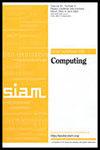跳数约束的遗忘路由
IF 1.6
3区 计算机科学
Q3 COMPUTER SCIENCE, THEORY & METHODS
引用次数: 0
摘要
我们证明了一种无竞争的无关联路由方案的存在性,从而解决了无关联路由中一个众所周知的问题。具体来说,考虑一个无向网络和一组数据包,每个数据包都有自己的源和目的地。目标是为每个数据包选择一条从源到目的的路径,使其达到最小,定义如下:膨胀是最大路径跳长,拥塞是包含任何单个边的最大路径数。路由方案不考虑其他数据包的存在,随机地为每个数据包选择一条路径。尽管存在这种遗忘,但所选择的路径在一个因子内具有最佳可能值。更准确地说,对于任何整数跳数约束,这种忽略路由方案选择最多长度的路径,并且与通过最多跳数的路径实现的最佳拥塞相比,在拥塞方面是竞争的。这些路径可以在多项式时间内采样。这个结果可以看作是Räcke著名的遗忘路由结果的类似物[第43届IEEE计算机科学基础研讨会论文集,2002;第40届ACM计算理论年会论文集,2008年],它们在拥塞方面具有竞争力,但在扩张方面没有竞争力。本文章由计算机程序翻译,如有差异,请以英文原文为准。
Hop-Constrained Oblivious Routing
We prove the existence of an oblivious routing scheme that is -competitive in terms of , thus resolving a well-known question in oblivious routing. Concretely, consider an undirected network and a set of packets each with its own source and destination. The objective is to choose a path for each packet, from its source to its destination, so as to minimize , defined as follows: The dilation is the maximum path hop length, and the congestion is the maximum number of paths that include any single edge. The routing scheme obliviously and randomly selects a path for each packet independent of (the existence of) the other packets. Despite this obliviousness, the selected paths have within a factor of the best possible value. More precisely, for any integer hop constraint , this oblivious routing scheme selects paths of length at most and is -competitive in terms of congestion in comparison to the best possible congestion achievable via paths of length at most hops. These paths can be sampled in polynomial time. This result can be viewed as an analogue of the celebrated oblivious routing results of Räcke [Proceedings of the 43rd Annual IEEE Symposium on Foundations of Computer Science, 2002; Proceedings of the 40th Annual ACM Symposium on Theory of Computing, 2008], which are -competitive in terms of congestion but are not competitive in terms of dilation.
求助全文
通过发布文献求助,成功后即可免费获取论文全文。
去求助
来源期刊

SIAM Journal on Computing
工程技术-计算机:理论方法
CiteScore
4.60
自引率
0.00%
发文量
68
审稿时长
6-12 weeks
期刊介绍:
The SIAM Journal on Computing aims to provide coverage of the most significant work going on in the mathematical and formal aspects of computer science and nonnumerical computing. Submissions must be clearly written and make a significant technical contribution. Topics include but are not limited to analysis and design of algorithms, algorithmic game theory, data structures, computational complexity, computational algebra, computational aspects of combinatorics and graph theory, computational biology, computational geometry, computational robotics, the mathematical aspects of programming languages, artificial intelligence, computational learning, databases, information retrieval, cryptography, networks, distributed computing, parallel algorithms, and computer architecture.
 求助内容:
求助内容: 应助结果提醒方式:
应助结果提醒方式:


